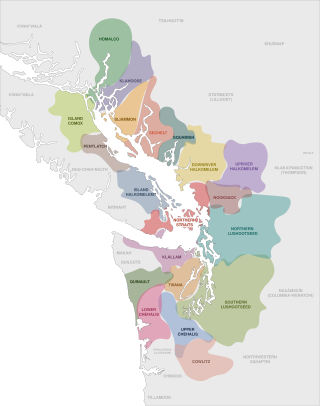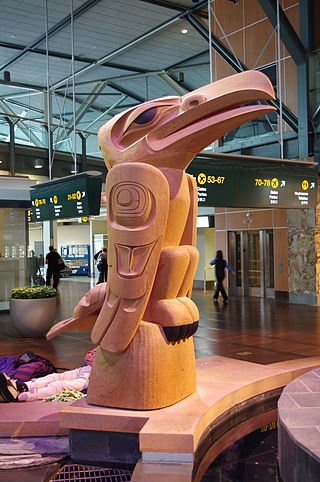
British Columbia is the westernmost province of Canada. Situated between the Pacific Ocean and the Rocky Mountains, the province has a diverse geography, with rugged landscapes that include rocky coastlines, sandy beaches, forests, lakes, mountains, inland deserts and grassy plains. British Columbia borders the province of Alberta to the east; the territories of Yukon and Northwest Territories to the north; the U.S. states of Washington, Idaho and Montana to the south, and Alaska to the northwest. With an estimated population of over 5.6 million as of 2024, it is Canada's third-most populous province. The capital of British Columbia is Victoria, while the province's largest city is Vancouver. Vancouver and its suburbs together make up the third-largest metropolitan area in Canada, with the 2021 census recording 2.6 million people in Metro Vancouver.

William Ronald Reid Jr. was a Haida artist whose works include jewelry, sculpture, screen-printing, and paintings. Producing over one thousand original works during his fifty-year career, Reid is regarded as one of the most significant Northwest Coast artists of the late twentieth century.

Emily Carr was a Canadian artist who was inspired by the monumental art and villages of the First Nations and the landscapes of British Columbia. She also was a vivid writer and chronicler of life in her surroundings, praised for her "complete candour" and "strong prose". Klee Wyck, her first book, published in 1941, won the Governor General's Literary Award for non-fiction and this book and others written by her or compiled from her writings later are still much in demand today.

The history of British Columbia covers the period from the arrival of Paleo-Indians thousands of years ago to the present day. Prior to European colonization, the lands encompassing present-day British Columbia were inhabited for millennia by a number of First Nations.

The Coast Salish languages, also known as the Central Salish languages, are a branch of the Salishan language family. These languages are spoken by First Nations or Native American peoples inhabiting the Pacific Northwest, in the territory that is now known as the southwest coast of British Columbia around the Strait of Georgia and Washington State around Puget Sound. The term "Coast Salish" also refers to the cultures in British Columbia and Washington who speak one of these languages or dialects.

Nootka Sound is a sound of the Pacific Ocean on the rugged west coast of Vancouver Island, in the Pacific Northwest, historically known as King George's Sound. It separates Vancouver Island and Nootka Island, part of the Canadian province of British Columbia. It played a historically important role in the maritime fur trade.

The Heiltsuk or Haíɫzaqv, sometimes historically referred to as Bella Bella, are an Indigenous people of the Central Coast region in British Columbia, centred on the island community of Bella Bella. The government of the Heiltsuk people is the Heiltsuk Nation, though the term is also used to describe the community. Its largest community is Bella Bella.

Sir James Douglas, was a Canadian fur trader and politician who became the first Governor of the Colony of British Columbia. He is often credited as "The Father of British Columbia". He was instrumental to the resettlement of 35 African Americans fleeing a life of racial persecution in San Francisco who arrived in the province aboard the steamship Commodore in what later became known as the Pioneer Committee. In 1863, Douglas was knighted by Queen Victoria for his services to the Crown.

The history of Vancouver, British Columbia, is one that extends back thousands of years, with its first inhabitants arriving in the area following the Last Glacial Period. With its location on the western coast of Canada near the mouth of the Fraser River and on the waterways of the Strait of Georgia, Howe Sound, Burrard Inlet, and their tributaries, Vancouver has – for thousands of years – been a place of meeting, trade, and settlement.

This is a bibliography of major works on the History of Canada.
Kitsumkalum is an original tribe/ galts'ap (community) of the Tsimshian Nation. Kitsumkalum is one of the 14 tribes of the Tsimshian nation in British Columbia, Canada. Kitsumkalum and is also the name of one of their Indian Reserve just west of the city of Terrace, British Columbia, where the Kitsumkalum River flows into the Skeena River. Archaeological evidence places Kitsumkalum with property holdings (laxyuup/territories) in the Kitsumkalum Valley, down the Skeena River to the coast, the Zymagotitz River, areas around Lakelse Lake and many special sites surrounding coastal and inland areas of the North West Coast prior to 1846 and as far back as 5,000 years BP.

Dempsey Bob, is a Northwest Coast woodcarver and sculptor from British Columbia, Canada, who is of Tahltan and Tlingit First Nations descent. He was born in the Tahltan village of Telegraph Creek on the Stikine River in northwestern B.C., and is of the Wolf clan.
Freda Diesing was a Haida woman of the Sadsugohilanes Clan, one of very few female carvers of Northwest Coast totem poles and a member of the Council of the Haida Nation of British Columbia, Canada. Her Haida name is Skil Kew Wat, meaning "magical little woman."

Northwest Coast art is the term commonly applied to a style of art created primarily by artists from Tlingit, Haida, Heiltsuk, Nuxalk, Tsimshian, Kwakwaka'wakw, Nuu-chah-nulth and other First Nations and Native American tribes of the Northwest Coast of North America, from pre-European-contact times up to the present.

Coast Salish art is an art unique to the Pacific Northwest Coast among the Coast Salish peoples. Coast Salish are peoples from the Pacific Northwest Coast made up of many different languages and cultural characteristics. Coast Salish territory covers the coast of British Columbia and Washington state. Within traditional Coast Salish art there are two major forms; the flat design and carving, and basketry and weaving. In historical times these were delineated among male and female roles in the community with men made "figurative pieces, such as sculptures and paintings that depicts crest, shamanic beings, and spirits, whereas women produced baskets and textiles, most often decorated with abstract designs."

This is a bibliography of works on the Provinces and territories of Canada.
Susan Point is a Musqueam Coast Salish artist from Canada, who works in the Coast Salish tradition. Her sculpture, prints and public art works include pieces installed at the Vancouver International Airport, the National Museum of the American Indian in Washington D.C., Stanley Park in Vancouver, the Museum of Anthropology at UBC, the Penn Museum in Philadelphia, and the city of Seattle.
Ulli Steltzer was a German photographer best known for her works photographing First Nations people and art in B.C., Canada, including Haida artist Bill Reid. Steltzer had numerous exhibits in and around Vancouver, and both Princeton University and the University of Victoria have collections of her works.












